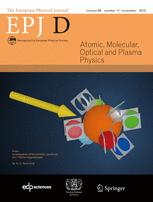Home > Press > Revisiting trajectories at the quantum scale: The role of statistics in quantum scale observation explains microscale behavior
 |
Abstract:
There is a gap in the theory explaining what is happening at the macroscopic scale, in the realm of our everyday lives, and at the quantum level, at microscopic scale. In this paper published in EPJ D, Holger Hofmann from the Graduate School of Advanced Sciences of Matter at Hiroshima University, Japan, reveals that the assumption that quantum particles move because they follow a precise trajectory over time has to be called into question. Instead, he claims that the notion of trajectory is a dogmatic bias inherited from our interpretation of everyday experience at the macroscopic scale. The paper shows that trajectories only emerge at the macroscopic limit, as we can neglect the complex statistics of quantum correlations in cases of low precision.
Revisiting trajectories at the quantum scale: The role of statistics in quantum scale observation explains microscale behavior
Heidelberg, Germany | Posted on June 8th, 2016The simple reason why it is wrong to assume that microscopic trajectories exist is because, in quantum mechanics, we can only approximately determine position and speed. This is due to a law of quantum physics, called the Heisenberg uncertainty principle, which prevents the experimental observation of trajectories and other continuous changes in time.
Hofmann shows that this uncertainty of time evolution is a result of the fundamental laws of motion. At the macroscopic limit, motion is described by a change in time along a trajectory of fixed energy. This relation between energy and time can be represented by an action. And this action is the origin of the mysterious effects of quantum coherent superimpositions and quantum interferences. The paper clarifies the role of actions by deriving equations for them that work equally well for quantum dynamics and for classical trajectories.
The paper thus explains for the first time why Planck's fundamental constant (h-bar or ?) can be used to objectively separate and distinguish macroscopic experience from microscopic physics. Indeed, h-bar identifies a fundamental scale at which the approximate separation of a motion from the interactions needed to observe that motion breaks down. Planck's fundamental constant therefore identifies a fundamental scale where there is an effective cross-over from observable realities to quantum mechanical laws of causality, where the action appears as a quantum phase (i.e one of the many alternative phases for a quantum scale system).
####
For more information, please click here
Contacts:
Sabine Lehr
49-622-148-78336
Copyright © Springer
If you have a comment, please Contact us.Issuers of news releases, not 7th Wave, Inc. or Nanotechnology Now, are solely responsible for the accuracy of the content.
| Related Links |
| Related News Press |
Quantum Physics
![]() Simulating magnetization in a Heisenberg quantum spin chain April 5th, 2024
Simulating magnetization in a Heisenberg quantum spin chain April 5th, 2024
Physics
![]() Simulating magnetization in a Heisenberg quantum spin chain April 5th, 2024
Simulating magnetization in a Heisenberg quantum spin chain April 5th, 2024
News and information
![]() Simulating magnetization in a Heisenberg quantum spin chain April 5th, 2024
Simulating magnetization in a Heisenberg quantum spin chain April 5th, 2024
![]() NRL charters Navy’s quantum inertial navigation path to reduce drift April 5th, 2024
NRL charters Navy’s quantum inertial navigation path to reduce drift April 5th, 2024
![]() Discovery points path to flash-like memory for storing qubits: Rice find could hasten development of nonvolatile quantum memory April 5th, 2024
Discovery points path to flash-like memory for storing qubits: Rice find could hasten development of nonvolatile quantum memory April 5th, 2024
Possible Futures
![]() Discovery points path to flash-like memory for storing qubits: Rice find could hasten development of nonvolatile quantum memory April 5th, 2024
Discovery points path to flash-like memory for storing qubits: Rice find could hasten development of nonvolatile quantum memory April 5th, 2024
![]() With VECSELs towards the quantum internet Fraunhofer: IAF achieves record output power with VECSEL for quantum frequency converters April 5th, 2024
With VECSELs towards the quantum internet Fraunhofer: IAF achieves record output power with VECSEL for quantum frequency converters April 5th, 2024
Discoveries
![]() Chemical reactions can scramble quantum information as well as black holes April 5th, 2024
Chemical reactions can scramble quantum information as well as black holes April 5th, 2024
![]() New micromaterial releases nanoparticles that selectively destroy cancer cells April 5th, 2024
New micromaterial releases nanoparticles that selectively destroy cancer cells April 5th, 2024
![]() Utilizing palladium for addressing contact issues of buried oxide thin film transistors April 5th, 2024
Utilizing palladium for addressing contact issues of buried oxide thin film transistors April 5th, 2024
Announcements
![]() NRL charters Navy’s quantum inertial navigation path to reduce drift April 5th, 2024
NRL charters Navy’s quantum inertial navigation path to reduce drift April 5th, 2024
![]() Discovery points path to flash-like memory for storing qubits: Rice find could hasten development of nonvolatile quantum memory April 5th, 2024
Discovery points path to flash-like memory for storing qubits: Rice find could hasten development of nonvolatile quantum memory April 5th, 2024
Interviews/Book Reviews/Essays/Reports/Podcasts/Journals/White papers/Posters
![]() Simulating magnetization in a Heisenberg quantum spin chain April 5th, 2024
Simulating magnetization in a Heisenberg quantum spin chain April 5th, 2024
![]() Discovery points path to flash-like memory for storing qubits: Rice find could hasten development of nonvolatile quantum memory April 5th, 2024
Discovery points path to flash-like memory for storing qubits: Rice find could hasten development of nonvolatile quantum memory April 5th, 2024
|
|
||
|
|
||
| The latest news from around the world, FREE | ||
|
|
||
|
|
||
| Premium Products | ||
|
|
||
|
Only the news you want to read!
Learn More |
||
|
|
||
|
Full-service, expert consulting
Learn More |
||
|
|
||








